Matador Network's Blog, page 878
April 17, 2020
Inside the era of virtual classrooms

The coronavirus pandemic is teaching humans all kinds of new things. How to occupy our Saturday nights when the bars are closed, how to get creative with at-home gym workouts, mastering the art of a social-distancing happy hour. In addition to teaching us these new skills, the virus is also changing the way we teach each other. With most schools around the country closed through the end of the year, learning has gone virtual. That’s new and potentially terrifying territory for many teachers who are accustomed to traditional classroom-style learning.
From kindergarten to universities, spring 2020 is the semester of online learning. That means teachers must not only worry about lesson plans and student engagement — already a monumental task — but also become technology wizards. While this poses a series of challenges, it’s also inspiring teachers to get creative with their new digital medium and explore the innovative possibilities of online learning that may endure long after this crisis is over.
From classrooms to Zoom
Social distancing didn’t exactly introduce the world to online learning. Technology has had an enormous presence in the classroom for years, and many children and adults were already taking advantage of online learning opportunities. What social distancing has done, however, is make virtual learning mandatory and necessitated a rapid shift in teaching style.
With just a few days to adjust, teachers have been tasked with adapting their curriculums to work in a virtual environment. And that swift transition hasn’t always been easy.
Megan Baron, a kindergarten teacher in Aurora, Colorado, acknowledged that “there was, and still is, a steep learning curve in this transition, but everyone is really working as hard as they can to make it as smooth as possible. We are all taking on a lot of new technology, strategies, and methods for what works best online. There are a lot of intricacies to think about — making sure that education is equitable in all ways during remote learning.”
To retain a semblance of connectivity, Baron does “weekly Zoom virtual meetings so that the kids can see me and their classmates. They have also responded well to online learning through Flip Grid, which lets them record brief videos of themselves, and other students can then watch their classmates’ videos back. As a teacher I can also leave comments and feedback on all of their posts and videos.”
For higher grade levels, however, the transition to online learning might prove a bit smoother. Academic institutions are more likely to be set up for online courses, and students have likely had more experience with technology and virtual learning.
Matthew Meltzer, the senior staff writer at Matador Network, also teaches writing for digital media at the University of Miami. Of his classroom’s transition to virtual learning, he says, “It was smooth in the sense that UM has a pro Zoom account, and it was easy to set up. Students understood how to set it up pretty easily. Doing lectures online isn’t hard, necessarily, since it’s really the same info presented with a screen. I had to make some small adjustments for stuff like quizzes but otherwise, technically, I didn’t find it too difficult.”
Getting online is one thing, learning online is another
Most teachers would probably tell you that one of the most rewarding aspects of their job is engaging with students and encouraging lively classroom discussions. Online learning makes this incredibly difficult. Although Meltzer employs various methods to promote student engagement, maintaining a cohesive classroom environment still proves challenging.
“You can’t really create a conversation,” he says. “You can’t create an environment. You can’t play off the energy in the room. It’s just a bunch of people staring at screens, and you’re trying to keep them engaged. And that’s really hard.”
On making sure students are paying attention, Meltzer says, “I try to get them to ask questions and have quizzes on the material. I require their video to be on, so I know they’re not making pico de gallo or doing laundry. This particular class, they weren’t ones to overly participate in class anyway, so there’s been a lot of dead air.”
For younger students, the virtual divide is even tougher.
According to Baron, “In kindergarten so much of our learning is about interacting with each other, learning to play and share together. This is virtually impossible to do without being physically together. Not being able to see the students every day is a huge drawback. I miss them so much!”
It’s not all negative

Photo: Maria Symchych/Shutterstock
Despite the clear inconveniences of teaching remotely, it’s not all bad for teachers. Just as students now have more flexibility to wake up late, roll out of bed, and simultaneously brush their teeth and take a pop quiz, teachers also find themselves with more freedom.
“Every day can be pajama day,” Baron joked, “and I can sleep a little bit later in the mornings.”
Indeed, for teachers who spend enough time outside the classroom grading papers and prepping lesson plans, saving precious commuting time is incredibly valuable. Meltzer similarly appreciates the time saved by foregoing the commute.
“I save an hour or two on not having to take the train to campus and back,” he said. “When I have them doing in-class writing, I can go make pico de gallo or do laundry or something else, so it has freed up some more time. You also sometimes get little glimpses into their lives, like posters on the wall in the background or people who walk by in the background to mess with them. So that’s kinda fun.”
Beyond simple convenience, online learning also has some educational upsides. Since transitioning to virtual learning, Baron says she doesn’t have to deal with behavior management in the classroom, which once took up a large portion of her time and distracted from learning objectives.
“This is a huge factor in the classroom,” she said. “During virtual learning each student is watching, listening, and learning the information and assignments on his/her own schedule. My colleagues are also coming together in a way that is above and beyond anything I’ve experienced in 18 years of teaching. Everyone is working together so well, even though we aren’t physically together.”
The future of virtual learning
Like many other aspects of post-pandemic life, education won’t exactly go back to “normal.” In other aspects of our lives, Zoom will probably play a bigger role in our social interactions. We’ll instinctively wash our hands more obsessively than we used to. And education — which had already been making big strides toward incorporating classroom technology — will likely embrace some online learning methods that proved successful.
While teachers will be relieved to get back into the classroom, and probably won’t lament the passing of the virtual-learning era, that doesn’t mean some strategies and techniques won’t carry over.
“I will absolutely use FlipGrid in my regular instruction,” Baron said. “It’s a great way to let students video themselves quickly and easily. I will also offer Zoom as a way to hold a parent-teacher conference if parents are unable to come into school to meet.”
Meltzer, however, is less eager to incorporate virtual learning into the classroom. “I might do things like Zoom conferences or Skype for guest speakers who are in different places,” he concedes, “or do it myself if I’m traveling and want to hold class anyway. I think learning that has been valuable so now I know that I can still hold class or have people come to class, even if they can’t be in Miami.”
As virtual teaching continues, the benefits and drawbacks of remote learning will become clearer. Teachers are doing their best to adapt to a difficult situation, evolve their teaching strategies, and creatively engage students. Until the whole picture comes into focus, however, the true merits of remote learning remain up for debate. 

More like this: How to use the unschooling approach to ease the stress of homeschooling
The post How teachers are adjusting to virtual classrooms appeared first on Matador Network.

What to do in St. Augustine, Florida

St. Augustine, on the coast of northern Florida, is the oldest continuously occupied European settlement in the United States. This town of about 15,000 has a rich and complicated history that’s reflected in its handsome architecture and dining options shaped by the city’s diverse cultures. St. Augustine also offers options for water sports, historic tours, ghost and pirate lore, and exotic animal encounters — all of which make this picturesque city just an hour south of Jacksonville the ideal place for a weekend visit.
Getting around
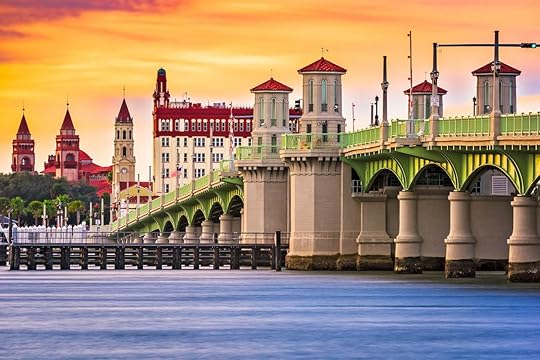
Photo: Sean Pavone/Shutterstock
St. Augustine doesn’t have a commercial airport, so if driving from home isn’t an option, you’ll have to fly into Jacksonville or Orlando and rent a car. Jacksonville is the closer of the two cities; Orlando is just under two hours south. We flew into Jacksonville, rented a 2020 Chevy Blazer to comfortably stash all of our luggage plus any souvenirs we’d collect along the way, and headed south to St. Augustine. Once in town, it’s necessary to drive or take a rideshare between the beach and historic district. The best course of action is to tackle one area per day, allowing you to walk between the attractions you want to see. If you’re going out bar-hopping in the evening, it’s easy to get a rideshare back to your hotel.
European-style architecture, Floridian hospitality

Photo: Sean Pavone/Shutterstock
Florida is 5,000 miles from the Mediterranean Sea, but nowhere in the south combines Euro-influenced architecture with beachy, coastal Floridian hospitality quite like St. Augustine. The architecture is as much a part of the show here as the beaches, starting with the Villa Zorayda Museum. Built in 1883 as the winter residence of hardware merchant and author Franklin W. Smith, this magnificent structure is a sight to behold, both inside and out. The Moorish Spanish revival museum includes architectural details borrowed from the Alhambra Palace in Granada, and it was built using Smith’s unique construction method: poured concrete and crushed coquina shells. The gilded, colorful interior is teeming with priceless antiques, including a sacred rug made from cat hair that’s more than 2,400 years old. The self tour of the museum takes about 45 minutes, and you can also reserve a docent-led guided tour in advance.
Another architectural hub is Flagler College, just off King Street across from the Villa Zorayda Museum. This private college boasts one of the most historically beautiful campuses in the country. The structure, planned and designed in part by oil mogul Henry Flagler, was finished in 1888 when it opened as the Hotel Ponce de Leon, an accommodation that was much needed in St. Augustine at the time. The building’s Spanish Renaissance style was, and still is, considered an architectural and engineering marvel.
Tours of the Flagler College campus, which include a comprehensive history of the buildings and grounds, take place every day at 10:00 AM and 2:00 PM. The afternoon tour allows you to do both the museum and college in the same day. Afterwards, sneak across the Bridge of Lions for a drink at Sarbez!, which serves up local craft beer and wine and a huge list of grilled cheese sandwiches. If you go on an evening with live music, expect it to be awesome but very loud.
If you’re a true architecture buff, book your overnight at the Casa Monica Resort & Spa, located in the center of St. Augustine’s Historic District within walking distance of many attractions and restaurants. The decor of the 1888 structure draws on Spanish Baroque Revival and Moroccan styles, although the building served not only as a hotel but also as a county courthouse. Another good place to stay in the bustling Historic District is the DoubleTree by Hilton Hotel, as it has a convenient location and amenities like a shuttle, which is helpful should you need a lift back after an evening on the town.
Watch the town’s cultural story play out in front of you

Photo: jo Crebbin/Shutterstock
Castillo de San Marcos was finished in 1695, which makes it the oldest masonry fort in the continental United States and the oldest structure in St. Augustine. The fortress was built by the Spanish to protect their claims in the New World, and when it came under fire by British troops for the first time in 1702, enemy forces were unable to penetrate its walls. Today, you can explore the many nooks and crannies of the fort, watch cannon firings, and learn about its long and complicated history from the many experts on site. The roof also offers a great view of the city and the water, so try your best to go on a clear day.
The town’s Colonial Quarter also offers live demonstrations along with plenty of boutique shops to peruse. Located along a stretch of St. George Street, this historic area is lined with storefronts, restaurants, bars, and museums. Along the route, you can catch a concert, watch a live musket demonstration, learn about blacksmithing, and shop wares from a variety of local artisans and businesses. After you’ve worked up an appetite, grab a bite at Columbia, a gorgeous Cuban and Mexican restaurant with a huge menu, or Prohibition Kitchen, a gastropub serving locally sourced fare.
Experience the living, the dead, and the water

Photo: lazyllama/Shutterstock
The St. Augustine Alligator Farm Zoological Park has been open for more than 100 years and is a leader in the species’ conservation. Here you can get up close and personal with reptiles, including the critically endangered orinoco crocodile and endangered Malaysian giant pond turtle, along with lemurs, monkeys, and exotic birds like the blue-throated macaw. You can even explore a python cave or zipline over the zoo if you’re looking for an edgier experience.
There’s also the option to take a guided ghost tour. Guided by professional storyteller Dion Moore, this small group walking tour combines the history and legends of the oldest US city into one freaky evening. Moore will take you to several supposedly haunted landmarks like the Oldest Wooden Schoolhouse, the Huguenot, and Tolomato Cemeteries, an old funeral parlor, as well as the ghostly St. George Inn. Whether you believe in the supernatural or not, the tour portrays the spine-tingling history of St. Augustine.
To mellow yourself out after the ghost tour, head over to the Intercoastal Waterway. Here, Raging Water Sports hosts guided water tours from the Matanzas River to the south and Tolomato River to the north. Jump on a jet ski or rent a motorboat to take advantage of bright sunny days where you can tour Guana State Park and the city’s historic bayfront. Expect gorgeous views and some wildlife sightings, like pelicans, ospreys, bottlenose dolphins, and even manatees in the summer months.
Where to eat and drink
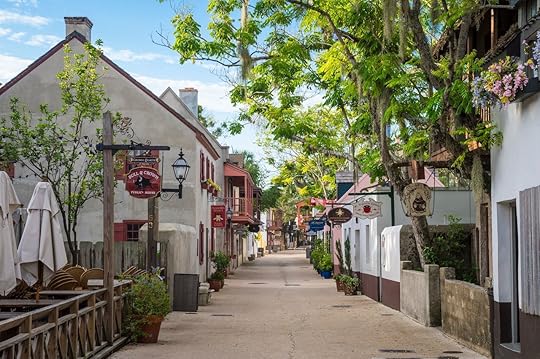
Photo: lazyllama/Shutterstock
Dining along Florida’s northern coast is about more than barbecue and fried fish. The cuisine of St. Augustine, in particular, has a distinctly European flair to it, led by Costa Brava. Located inside the Casa Monica Resort & Spa, this semi-formal restaurant infuses Mediterranean flavors with Spanish-style tapas plates. Order an expertly made martini or spicy margarita from the bar before diving into the food menu, meant to be shared among large tables. Start with a perfectly cooked plate of Florida white shrimp seasoned with garlic, olive oil, and adobo spice, or try the Hunter’s Board, piled high with Spanish cheese, charcuterie, nuts, and olives.
Another option popular among locals and regular visitors is the Ice Plant Bar. This stunning bar and restaurant is housed in a former ice plant in a building that dates back to 1927. Look up when you enter because you can still see the crane rails above the bar that used to lift huge blocks of ice to be broken down for customers. Now that gorgeous ice is used to chill the establishment’s signature cocktails like the Mazzy Star, which is mixed with vodka, Absentroux (an absinthe liqueur), falernum, grenadine, and lemon. The food here is excellent too, especially the homemade potato chips and Fancy BLT. When you’re done eating and drinking, head downstairs and take a tour or tasting at the connected St. Augustine Distillery.
The town’s best vegetarian meal is found at Sprout Kitchen. Located on a charming side street off the Colonial Quarter, this plant-based cafe and juice bar is a perfect place to stop in for breakfast or lunch. Inside the sunny space, you’ll find a variety of fresh, cold-pressed juices, smoothies, vegan and gluten-free baked goods, and savory dishes like a delicious Caesar salad with crispy chickpeas. Don’t miss the avocado toast topped with killer coconut “bacon,” pink salt, and cayenne pepper. 

More like this: Biscayne National Park is the perfect day trip from Miami
The post St. Augustine combines European charm with Floridian hospitality appeared first on Matador Network.

Social distancing park in Austria

Right now, social distancing must conform to the pre-existing spaces in our lives. It’s up to us to navigate parks, sidewalks, and walking trails in a safe and responsible way, because those spaces were not built to accommodate the reality of COVD-19.
Austrian design studio Precht wants to make social distancing easier for those who live in urban areas and still want to enjoy green spaces, so it designed “Parc de la Distance.”

Photo: chrisprecht/Instagram
The ingenious and beautiful curvy park would have tall and wide hedge divisions, to allow people to be outdoors while keeping a safe distance from one another. The park would feature several winding 20-minute routes that would lead to the center of the park where individual water fountains would be located. Gates situated at the entrances and exits to each route would indicate whether a route is occupied.

Photo: chrisprecht/Instagram
The park would not only be a practical way to spend time in nature during the COVID-19 crisis, but it’s also a beautiful piece of landscape design that would transport urbanites into a sanctuary of peace and solitude long after the health crisis has passed.
During an interview with Dezeen, studio founder Chris Precht explained, “For now, the park is designed to create a safe physical distance between its visitors. After the pandemic, the park is used to escape the noise and bustle of the city and be alone for some time. I lived in many cities, but I think I have never been alone in public. I think that’s a rare quality.”
“Parc de la Distance” has been proposed for Vienna, Austria, which was rated the world’s most livable city in 2018 and 2019. 

More like this: These elevated green spaces are the future of urban parks
The post Austrian design studio plans stunning maze-like park for social distancing appeared first on Matador Network.

Lion sleeping on roads in Kruger NP

Animals have been taking true advantage of lockdown conditions all around the world, filling the void left but humans on city streets and in parks.
While mountain goats take over Wales and coyotes make themselves at home in the empty streets of San Francisco, in South Africa’s Kruger National Park, lions, impalas, zebras, African wild dogs, hyenas, and giraffes have taken up residence on the roadside and on golf courses.
Park ranger Richard Sowry took some photos of a pride of lions sleeping peacefully on the tarmac road just outside Orpen Rest Camp.
Kruger visitors that tourists do not normally see. #SALockdown This lion pride are usually resident on Kempiana Contractual Park, an area Kruger tourists do not see. This afternoon they were lying on the tar road just outside of Orpen Rest Camp.
Bookstore delivers mystery bags
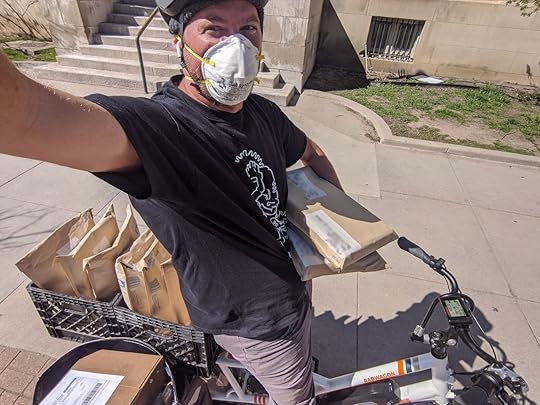
Since people can’t visit bookstores to get their regular literary fix, businesses are getting creative with ways to give customers the reading material they crave.
When all nonessential businesses in Boulder, Colorado, were ordered to close, Trident Booksellers and Cafe was faced with a decision: close completely, or find an ingenious solution to stay afloat and satisfy its customers. Rather than throw in the towel, the shop decided to bring books directly to its customers via bicycle delivery.

Photo: Andrew Hyde/Trident Booksellers and Cafe
While no one is allowed to enter the shop until the lockdown is lifted, Trident is still taking online orders for “mystery bags” of books, and delivering them to customers’ doors. By early April, they had already sold over 300 bags, proving that people are keen to help their local businesses and enjoy a surprise.
Each bag costs $50, and is packed with four to six used books chosen by staff with input from the customer. Customers might specify their preferred genre, in which case staff will fill the bag with works from that genre. Along with the “mystery bag,” customers will also receive a bag of coffee beans or tea, to really get the full cafe experience that they currently cannot have.
Andrew Hyde, one of the store’s owners, told Atlas Obscura, “About half [of the customers] are Boulder locals and the other half are from around the world […] It’s so much fun to pick great books for people.” For locals, the books are delivered on bicycles by one of the staff members, but for those who live further, the books are sent via UPS for only $5.
And the delivery business seems to be booming.
“We ran out of delivery bags and coffee bags,” Hyde said, “Then we ran out of shipping envelopes three times.”
For some community members placing orders, the contents of the bags aren’t important. It’s all about showing support for Trident.
Boulder resident Mike Gerhard told Atlas Obscura, “I ordered a bag because I’m friends with Andrew [one of the four owners of Trident Booksellers and Cafe] and wanted to support a local business. I want to support as many local businesses as I can through this.” 

More like this: The 28 coolest independent bookstores in the US
The post A Colorado bookstore delivers ‘mystery bags’ of books via bicycle to customers on lockdown appeared first on Matador Network.

April 16, 2020
Dogs may learn to sniff out COVID-19

The London School of Hygiene & Tropical Medicine (LSHTM) is working to prove that dogs can be trained to assist in preventing the spread of COVID-19. Recently, canines were trained to detect malaria, and now the same team at LSHTM is starting to train dogs to provide a quick, non-invasive coronavirus diagnosis.
Researchers believe that dogs could serve as a useful and much-needed supplement to coronavirus testing, becoming familiar with the virus’s scent, and detecting subtle changes in patients’ skin temperatures.
According to Professor James Logan, Head of the Department of Disease Control at LSHTM, “Our previous work demonstrated that dogs can detect odors from humans with a malaria infection with extremely high accuracy — above the World Health Organization standards for a diagnostic. It’s early days for COVID-19 odor detection. We do not know if COVID-19 has a specific odor yet, but we know that other respiratory diseases change our body odor so there is a chance that it does. And if it does dogs will be able to detect it. This new diagnostic tool could revolutionize our response to COVID-19.”
“The aim is that dogs will be able to screen anyone, including those who are asymptomatic and tell us whether they need to be tested,” said Dr. Claire Guest, CEO and co-founder of Medical Detection Dogs. “This would be fast, effective and non-invasive and make sure the limited NHS testing resources are only used where they are really needed.”
Much like bomb-sniffing, dogs could be used to identify infected passengers at airports and other public places. This would be crucial for keeping the virus under control after the first wave has been suppressed. 

More like this: The 7 best places in the world for dog lovers
The post Dogs may be trained to sniff out coronavirus to help stop the spread appeared first on Matador Network.

Vancouver Aquarium may close forever

The consequences of the COVID-19 pandemic reach much further than anticipated. Due to its closure on March 17, the Vancouver Aquarium, for example, has lost over $2 million. The loss of income might soon mean the permanent closure of one of Vancouver’s most-visited sites and the relocation of the tens of thousands of animals in its care.
“Unlike other institutions,” said the aquarium’s president Lasse Gustavsson, “we can’t just lay off our people, switch off the light and go home. We have 70,000 animals we take care of and that we care a lot about.”
The aquarium, a not-for-profit operation has already laid off about 340 employees, i.e. about 60 percent of the staff, and the remaining staff is working part-time, while senior management is taking pay cuts. But feeding the animals costs over $700,000 per month.
Although the aquarium did receive government funding from upgrades and expansions, it’s a “self-supporting” institution, meaning it does not fund its day-to-day operations through taxpayer dollars but mostly through the sale of tickets. Without aid from the federal or provincial government, the aquarium won’t be able to survive for more than a few months.
“We have two, max three more months to run the operation,” said Gustavsson, “unless we get any additional support from the outside.”
Closing the aquarium would mean 70,000 animals would need to find a new home, so they’re doing everything they can to find funding, including asking for public donations.
“We can’t expect the public to provide us with the funding necessary,” said Gustavsson, “simply because everybody’s having a hard time and running the aquarium is expensive. So I think we are looking primarily at the government and (a few individuals and corporations) who can give generously, in large amounts.”
The aquarium first opened in 1956 and is run by the Ocean Wise Conservation Association. 

More like this: Where to swim with the world’s most amazing marine wildlife
The post The Vancouver Aquarium could close permanently because of COVID-19 appeared first on Matador Network.

Princess Sofia helping during COVID

You might not be a nurse or doctor, but that doesn’t mean you can’t still lend a hand in the fight against the coronavirus. Princess Sofia of Sweden — the wife of Prince Carl Philip — is leading by example, taking a three-day medical emergency training course that will qualify her to volunteer at Sophiahemmet Hospital in Stockholm. She won’t be treating patients but will instead be providing valuable assistance by disinfecting medical equipment, cleaning, performing kitchen work, or supporting the medical staff in other ways.
According to a spokesperson for the royal court, “In the crisis we find ourselves in, the Princess wants to get involved and make a contribution as a voluntary worker to relieve the large workload of healthcare professionals.”
And you don’t have to be a member of the royal family to get involved. The online training is run by Sophiahemmet University and open to anybody. It prepares people without medical experience to assist in the medical environment in a wide range of different capacities. This includes a variety of different support roles, which aren’t patient-facing but are still incredibly valuable.
The princess, who has served as the hospital’s Honorary Chair since 2016, isn’t new to public service. Most recently, she helped set up Prince Carl Philip and Princess Sofia’s Foundation, which aims to fight online bullying and discourage hate speech. 

More like this: Ireland’s prime minister is returning to medicine amid the coronavirus pandemic
The post Princess Sofia of Sweden will assist medical workers during the pandemic appeared first on Matador Network.

Edgar Allan Poe on Sullivan's Island
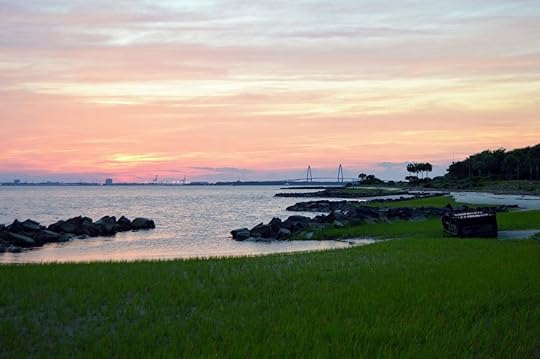
On a recent trip to the Isle of Palms, it took less than a day to learn that one of America’s original horror writers, Edgar Allan Poe, is a source of obsession in this small corner of South Carolina. The Uber driver taking me from my hotel 20 minutes southwest to nearby Sullivan’s Island my first day there took it upon himself to educate me.
“Did you know Edgar Allen Poe lived on Sullivan’s Island?” He asked. I did not know. “He joined the military under a pseudonym.”
I’ll admit I didn’t think much of comment until he dropped me off at the small strip of restaurants that comprise Sullivan’s miniature downtown area. There’s a cafe called Coop’s that serves frozen rosé to go and a gourmet pizza restaurant called The Obstinate Daughter. But by far the island’s most well known, and arguably its most popular restaurant, is Poe’s Tavern.
The restaurant serves classic American fare — fish tacos, pimento smeared burgers, and local beer — but it’s dedicated to Poe. Namely his face, in several different iterations. The walls are plastered with Poe-themed artwork: movie posters, hand-painted recreations of his famous daguerreotype. His portrait is even painted on the red brick above the fireplace. Poe’s taciturn smirk is inescapable here.
To understand why Poe holds such a revered place in the history of Sullivan’s Island, you have to go all the way back to the early 1800s.
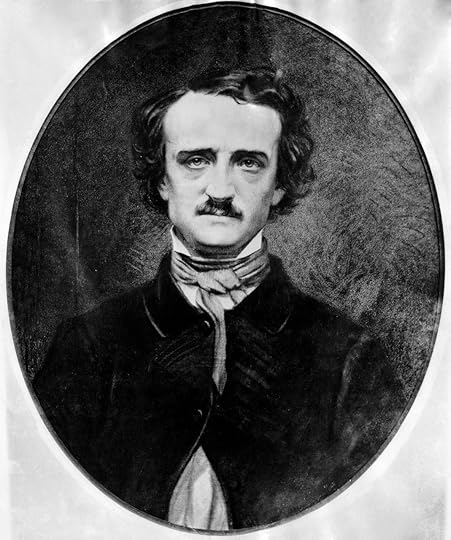
Photo: Everett Historical/Shutterstock
“Poe joined the Army after dropping out (flunking out, partying his way out?) of the University of Virginia. He joined under the assumed name E.A. [Edgar] Perry,” Mike Walsh, a historian and tour guide at the Battery Gadsden Cultural Center on Sullivan’s Island, tells me. Poe was just 18 years old at the time.
Despite the fact that Poe enlisted under a pseudonym because he was ashamed of his reduced position in life, he thrived in the military. Walsh supposes that his success might have stemmed from the fact that he completed more formal education than his compatriots and “because for the first time in his life he had some structure.” In fact, Poe was so desperate to rewrite his own history that he would later fabricate escapades in Greece and Russia to account for the years he spent in the service.
Poe served as an artificer, which is a specialist in artillery. He rose to highest rank afforded to enlisted men at the time: regimental sergeant-major. In 1829, he was discharged from the service, just one year after his company was transferred to Point Comfort, Virginia. He lived on Sullivan’s Island for just 11 months, but Poe’s time on Sullivan’s Island stuck with him, and he ended up using the setting as inspiration for one of his most popular stories, thereby solidifying his status as a South Carolina icon.
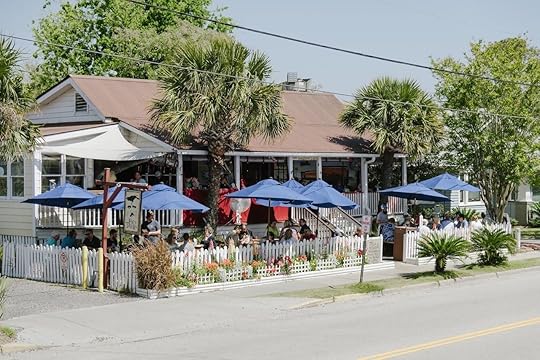
Photo: Poe’s Tavern – Sullivan’s Island/Facebook
“It was his use of Sullivan’s Island in ‘The Gold Bug’ that has led to some of our streets being named Goldbug, Poe, and Raven,” Walsh says. “Back on Goldbug Street there is a massive live oak tree nicknamed the Goldbug tree.”
“The Gold Bug” is an homage to South Carolina. Its opening pages describe Charleston (another story, “The Oblong Box,” also references the city) before it comes to his depiction of Sullivan’s Island: “The island is a very singular one. It consists of little else than the sea sand and is about three miles long. Its breadth at no point exceeds a quarter of a mile. It is separated from the mainland by a scarcely perceptible creek, oozing its way through a wilderness of reeds and slime…”
If you’re visiting the nearby Isle of Palms, a slender barrier island off the coast of South Carolina that’s dotted with beach front condos, you might recognize his description. There’s also a good chance you’re going to drive by Wild Dunes resort, an expansive 1,600-acre complex at the east end of the island. That golf course holds the key to the island’s most widespread legend regarding Poe.
Jeff Minton, the director of golf at Wild Dunes resort, moved to Isle of Palms 16 years ago from Arizona. When he started working at the resort’s golf course in 2005, his colleagues passed a strange tale down to the unsuspecting Minton, who had never read a word of Poe before arriving on Sullivan’s Island.
Minton learned that the legend sprung up straight from the plot of “The Gold Bug.” In the story, a destitute former aristocrat named William Legrand finds a scarab beetle made of pure gold. Legrand discovers that the beetle is the key to finding buried treasure left behind by Captain William Kidd, a Scottish sailor executed for piracy in 1701. Legrand decodes a cryptogram hidden on a piece of parchment and follows the resulting directions to the treasure. The legend has since evolved. Locals now claim that the treasure map led to a tree on the Isle of Palms — a tree that is now located on the 14th fairway of the Wild Dunes Resort golf course.

Photo: Wild Dunes Resort/Facebook
“Over the years that tree has deteriorated, so we had to put concrete in between where the tree might split in two,” Minton says, “so if anybody asks, ‘What’s that concrete over there near number 14,’ I’ll tell them, ‘Well allegedly that’s the tree in ‘The Gold Bug’ where Edgar Allan Poe looked for buried treasure.’ People like to take pictures with it.”
The legend, like most legends, is not strictly true — there’s no evidence Poe ever searched for the treasure himself — but South Carolinians have long been eager to claim Poe as a uniquely Southern writer. And for good reason: Today, Poe’s name is synonymous with the Southern Gothic literary genre though he was born in Boston.
According to an article by College of Charleston professor Scott Peeples, a member of the Poetry Society of South Carolina named John Bennet helped fundraise efforts in 1922 to erect an Edgar Allen Poe shrine in Richmond, Virginia, where Poe lived for many years. The shrine, and a museum dedicated to the writer, still stand today. That dedication to Poe’s memory did not fade with time. From 2007 to 2011, Sullivan’s Island resident Carol Antman produced the play “Edgar Allan Poe: Back From the Grave” at the Creative Spark Center for the Arts (which is now closed).
“It involved vignettes staged in the various rooms within [Fort Moultrie’s] labyrinthine hallways: poems, scenes, Poe himself writing,” Antman wrote to me in an email. “One year there were sword fights, one year the audience danced. We brought in a special effects company that added projections and stage lighting including a heartbeat that could be heard for blocks. It was always different.”
It’s not surprising that Poe was drawn to the South. Poe crafted an aura of mystery around his life, and the writing itself fit the writer’s reputation. He is considered one of the inventors of the detective fiction genre, and his macabre mysteries are equal parts thrilling and spine-tinglingly creepy. The Southern landscape is replete with some of these traits — ghostly, haunted marshal; deserted islands overgrown with vegetation; old, creaking houses with history imbued in their very walls. No wonder Poe found a place like Sullivan’s Island, which was more an unexplored wilderness back then than the vacation destination it is today, ripe for a tale of murder and intrigue.
On Oct. 3, 1849, 19 years after Poe graduated from West Point, he was found delirious, wandering the streets of Baltimore, wearing clothes that did not belong to him. He died like he lived — under mysterious circumstances that are still the subject of much speculation. Perhaps he would be surprised to learn how deeply he impacted a place where he spent so little time, but Poe would probably be pleased that legends of buried treasure and pirates still linger on the island long after his death. 

More like this: In South Carolina, Gullah-Geechee cuisine gets its long overdue moment in the spotlight
The post On Sullivan’s Island, Edgar Allen Poe’s mysterious legacy lives on appeared first on Matador Network.

NYC to sing ‘New York, New York'

Singing during quarantine is not a new development, but if every New Yorker turns out for this planned singalong tonight, it’ll certainly be a spectacle unlike any other. This evening, New Yorkers plan to come together in song, belting out a number Yankees fans are quite familiar with — Frank Sinatra’s “New York, New York.”
The event, which is being dubbed “New York Sings Along” will be led by the Peace of Heart Choir, and everyone’s invited. The singalong will take place promptly at 7:02 PM, directly following the nightly round of applause for the city’s healthcare workers.
Andrew Dykeman, co-chairman of the choir, said in a statement, “Today, our communities are disrupted — we cannot gather as we normally do to rehearse and perform, talk and discuss, drink, eat, practice yoga, meditation, exercise, or even work. At the same time, while so many of us are sheltering in place, others New Yorkers tirelessly fight the global pandemic and help maintain essential services, laboring in the city’s hospitals, restaurants, supermarkets, bodegas, subways and buses, and more.”
To join in, go to the event’s Facebook page or tune into WKCR (89.9FM) or WBAI (99.5) for a livestream. Then just lean out your window or stand on your balcony, and do your best Sinatra impression. 

More like this: The ultimate LGBTQ guide to New York City
The post New Yorkers will belt out ‘New York, New York’ from their windows and balconies tonight appeared first on Matador Network.

Matador Network's Blog
- Matador Network's profile
- 6 followers



